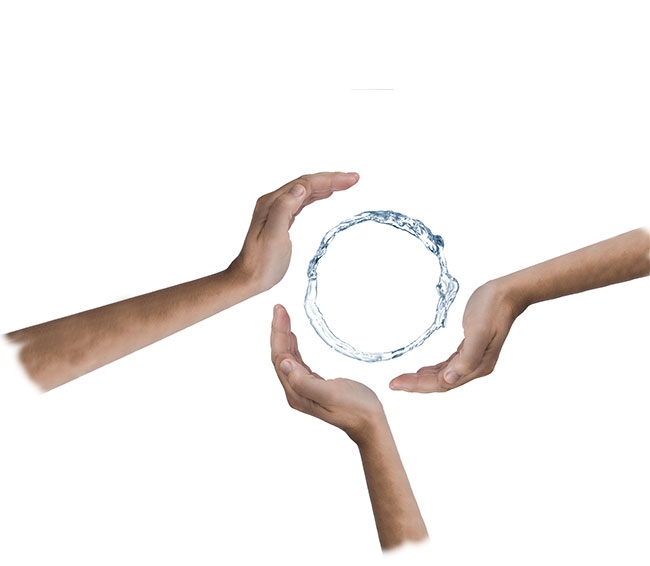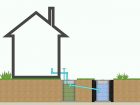
News
Spirit of collaboration
OGWA, OOWA and CWQA have much in common
April 25, 2017 By Carolyn Camilleri
 Photo: Fotolia
Photo: FotoliaDespite doing very different jobs, the water well, water treatment and septic industries have much in common. They often share customers, and obviously, must co-ordinate to meet regulations.
Frequently, the equipment manufacturers are the same. Most of all, they share a major priority: the protection of ground water. But how well do the three industries communicate? And could they do a better job?
David Cousens from Kinburn Plumbing in the Ottawa area believes they can.
“Everyone is concerned about protecting ground water. You’ve got the drillers. You’ve got the wastewater people. You’ve got the water treatment people. But it seems to be, everyone’s operating in silos,” Cousens says. “I’m not saying each organization has to give up what they do, but they seem to operate so independently of each other. It would be incredible to see the silos brought down between industries with the same goal.”
Despite clear differences such as training, licensing and the actual work, in these days of advanced technology, reduced demand and increased challenges from land development, there may be more reasons than ever for the industries to align interests and co-ordinate efforts.
Rick Esselment, past president of Ontario Onsite Wastewater Association (OOWA) and a member of both the Ontario Ground Water Association and the Canadian Water Quality Association (CWQA), says there is synergy between the three associations.
“The challenges are logistics with each of the associations and the business models of the associations. It’s not policy. It’s not overlap. It’s not disagreement. We all agree on protecting our natural resources, and in particular, ground water and the impact that water quality has on the communities that we’re serving,” Esselment says.
In fact, all three organizations – OGWA, OOWA and CWQA – get along quite well. Kevin Wong, CWQA’s executive director, says increased collaboration between the three organizations has been an ongoing topic of discussion for about a decade.
“CWQA and OGWA have enjoyed a very close relationship and have collaborated on a number of topics,” Wong says. “In the last few years, both organizations have made inroads in collaborations with OOWA.”
Involvement has increased in recent years
“The intention is to collaborate more closely on crossover topics, code, regulations and legislation changes,” Wong says. “Last year, all three organizations met to, for the first time, officially begin that formal collaboration framework with an agreement in principle to co-operate, communicate, invite each other to respective conferences, and meetings, and assist in opening doors for each other in a complementary manner.”
By way of example, he says CWQA has the ability to comment on code changes in bulk, as they did last year for Ontario and then shared comments with OGWA and OOWA to remain transparent.
“We are also cognizant of their concerns in the field with Ministry of the Environment and Climate Change and the Ontario College of Trades and such in those areas,” Wong says, noting they can feed information about changes to their partners and responses can be funnelled through the CWQA.
It’s a promising example of collaboration and an indication of future potential.
Sharing information
Cousens would like to see more collaboration around sharing information and resources. Esselment agrees and offers an example to illustrate the potential.
“The building code requires a setback distance or lateral separation distance between certain types of wells and different septic system components,” Esselment says. “But there are very few instances where a septic installer will contact a local well driller to ask them about where the wells are or the type of well that it is. It’s just kind of a guess. To me it’s absurd because those professionals live in the same communities.”
Information sharing could be streamlined through the Ministry of the Environment and Climate Change.
“Licensed well drillers upload their well records to the province, so the province has a database of wells that are registered,” Esselment says. “With septic systems, it’s a building code, which is provincial, but they’re regulated locally, not by the province.”
The local building official, local conservation authority or local health unit implements the provincial regulation, Esselment adds, but then the records are also kept locally.
“It would be nice to see, long term, if the municipalities could upload their permits to the Ministry of the Environment, so they could comingle data from where the wells are and the types and locations of the septic systems,” he says. “It’s that simple.”
And in a digital world, it only makes sense. Moreover, in some cases, municipal records are kept for only seven years, while the wells are in operation for much longer.
“I think we can do better than that,” Esselment says. “We could use that data provincially to look at the types of wells and the types of septic systems. We can use that data in a more meaningful way to inform better policy. But it could also be searchable by contractors on either the water or the wastewater side, because they’d have a common location to search those records.”
“It’s infrastructure that we’re building,” he says.
Conferences and trade shows
Over his years in business, Cousens has developed close relationships with representatives for equipment manufacturers on both the “clean and back water” sides.
“The same comments come up every year,” he says. “The cost of supporting two industries separately is such a burden that many are picking one or the other for convention attendance.”
Cousens feels the industries and the manufacturers would benefit from jointly held trade shows, with each organization hosting its own meetings during the event. Esselment agrees there would be some economies of scale for each of the associations.
“The challenge is logistics,” Esselment says, noting that the OOWA convention drives a profit to their bottom line that allows them to operate. “It comes into a business strategy, but we can overcome that, because most of the people involved are businesspeople and we all know each other.”
It comes down to two things: timing the event so that it works for each industry and finding a venue that’s suitable for a broadened event. It would indeed be a very large event.
A stronger voice
Perhaps the most significant benefit to co-ordinating the efforts of the three industries is to have a more unified message and a stronger voice. As Cousens says, the underlying connection is ground water, but self-preservation is an ongoing concern.
“Most municipalities now have tentacles of water pipes and sewer pipes heading all over the country, and it’s certainly a bit of a threat to the well water industry and for the sewer industry,” he says.
While the push for small communities to join the grid is strong, the reason for lightening up on that push is not only to preserve livelihoods. Limiting the expansion of the grid is often purely and simply a smarter decision.
Craig Stainton, executive director of OGWA, points to the energy and money needed to connect rural areas to a municipal water and sewage grid, especially at a time when concerns over climate change and carbon footprint are at a peak.
“What makes sense to me is a well with a fractional horsepower pump using a small amount of hydro that the homeowner pays and a septic system which should be designed to work on gravity and all on the homeowner’s dime, no grants involved,” Stainton says. “What could be greener, what could change the climate less, where would there be less carbon footprint, and what would be less taxing on provincial coffers?”
Esselment agrees and says decentralized systems can work well in urban areas, too, for example, wells and septic serving residential clusters in subdivisions, as opposed to them linking to the town water and sewage.
“We’re not fighting development: we’re advocating for smart development, because even urban centres could benefit from a distributed or decentralized approach to growth,” Esselment says. “That language is important to make sure each of the groups is aligned with that message that we’re not necessarily fighting it back or fighting against something. We’re definitely fighting for something as a better alternative.”
Getting support means educating communities, the public and the various levels of government. Efforts are needed on several fronts. Stainton says, “The real hurdle is getting the government folks backed against the wall where they have to a) acknowledge that the current method of development is not smart, green or carbon friendly, b) take on the regulatory change which will be needed to force the developers to change their methods, and c) get the public on board with a bit more capital cost up front for less ongoing cost and less impact on the environment/climate change.”
Esselment says there are presently two key challenges with provincial policy in Ontario. The first is that the provincial policy statement advocates for centralized systems or municipally owned infrastructure, which planners and developers commonly interpret as linking to the “big pipes.”
“But what it really says is municipal ownership of whatever solutions the municipality wants,” Esselment says. “It’s really about policy, not the efficacy of the treatment or the quality of the water. That’s the part we have to highlight, that we all have proven technologies and proven solutions, but the provincial policy is to try to connect all the pipes because that inherently connects responsibility.”
He explains that we definitely want responsibility to be taken by the largest entity. With better policy, better regulatory tools, such as a centralized database where information could be uploaded, responsibility for decentralized systems can be connected to the largest entity.
Esselment says it would be a game changer in terms of individual property responsibility, because the province would know what’s happening on every property.
“If you connect the information, you don’t have to connect all the pipes,” he says.
Another challenge is funding for smaller municipalities: they have to have a certain number of user connections to justify the expense of connecting to the grid and they have to borrow the money to do the installation.
“The small municipalities cannot afford their existing water and sewer systems, nor to renew them or update them. They can’t afford that now. It’s absurd to think that you would extend that system further abroad,” Esselment says. “It’s basically stealing from the future to pay for the present.”
It makes more sense for smaller communities to choose a scale or blend of water and wastewater servicing that meets both mid-term and long-term needs. This is where lobbying is important, he says, as there is no money from the government available to fund small-scale projects.
“[Government] funds the biggest pipe available and that is a challenge, because when you actually want to do smart, scalable infrastructure, you have to self-fund it. There are no programs federally and really not very many provincially that will allow you to fund this renewal,” Esselment says.
Consequently, when a small community wants funding to improve its water and sewage infrastructure, in addition to providing evidence that they have an infrastructure problem and potentially a health risk, they may also vilify wells and septic systems.
“That’s unfair to the actual industries and the communities that use that infrastructure,” Esselment says.
A stronger, clearer and truthful message supported by all three industries is critically important, he emphasizes.
“Connect the voices of all the people that are advocates for improved professional practice, continue to renew the right-scale infrastructure – rather than replacing small-scale with large-scale – having an industry voice that combines people that are servicing rural Ontario for water-wastewater infrastructure,” Esselment says. “We’ve been at this for the better part of a decade now, and to be very clear, it’s gaining momentum in terms of who will listen to the message now, because it’s about finances. It’s about communities being able to afford their future.”
And that brings us back to the collaboration of industry associations, and by extension their memberships: the businesses and community stakeholders involved in decentralized and distributed infrastructure development. The groundwork is already there. As Wong says, “The OOWA-OGWA-CWQA relationship is strong and can only get stronger with our commitment to collaborate, communicate and co-operate.”
Carolyn Camilleri is a Toronto-based writer, editor, and content strategist. She has been writing for consumer and trade magazines, as well as businesses and organizations across the country, for more than 15 years.
Print this page

